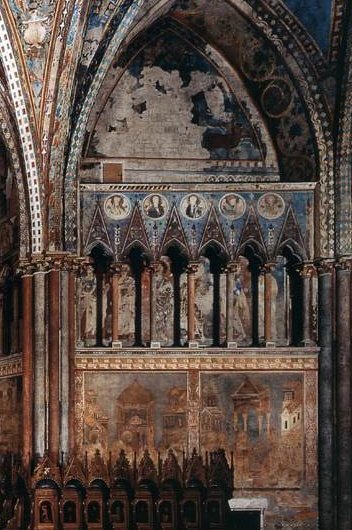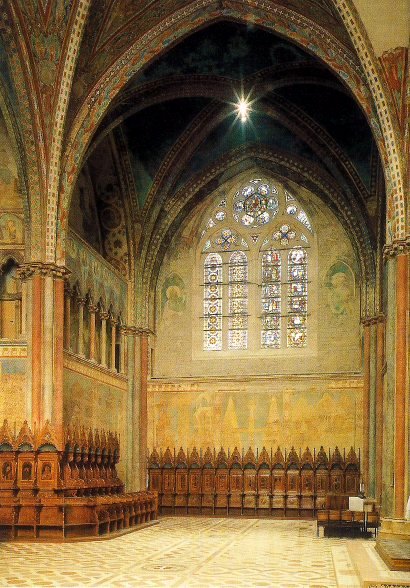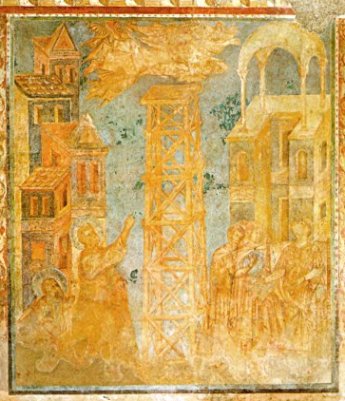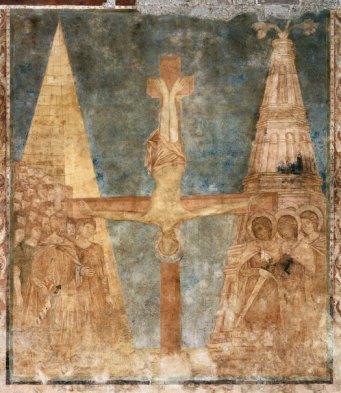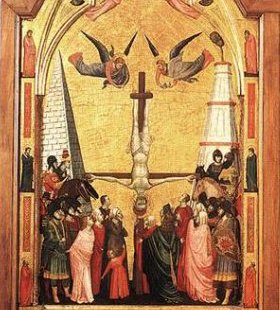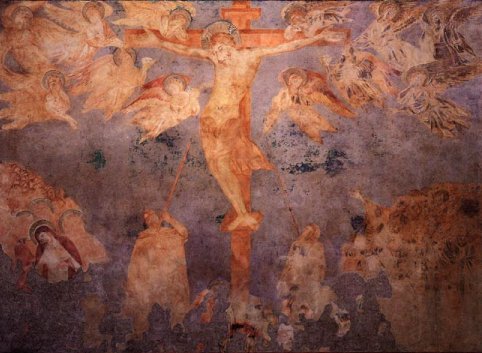|
Upper Church: North Transept |
|
|
S |
|
| This is the north
west wall, adjacent to the apse. The top register shows God the father surrounded by the symbols of the evangelists, though little of this is left. The middle register has a row of angels, beneath which are the apostles, placed here to symbolically mediate between heaven and Earth. Below that the story of the early church continues, with images of St Peter. |
|
|
|
|
|
|
|
To the side of the window on the North wall there are images of the prophet Elijah (left) and King David (right). Below this the story of St Peter continues, followed by an image of St Paul. |
|
|
|
|
|
The Fall of Simon Magus |
The Martyrdom of St Peter |
|
|
|
An aside: St Peter and the pyramids. In the image of St Peter's martyrdom, we see him between two pyramids. This is based on an old legend than Peter was crucified upside-down in Rome, 'between two pyramids', one being the pyramid that formed the tomb of of Romulus known as the Meta Romuli. Rome did like pyramids; one remains, the pyramid of Caius Cestius, though it does not seem that this is one of the ones represented here. The Meta Romuli was near the Vatican, while the pyramid of Caius Cestius is 4 km. away. Contemporary descriptions of the Meta Romuli are quite vague, so it is not clear which of the two pyramids in the painting it is. The Meta Romuli was demolished in 1499, which indicates that medieval artists would have been familiar with it. Interestingly, there are two other examples of the portrayal of existing buildings in the Upper Church - see bay 4. In art of this period, the pyramids were often included in images of St Peter's crucifixion: here is a panel from the Stefaneschi altarpiece by Giotto. The resemblance to the Assisi fresco is marked, yet the altarpiece was painted around fifty years later. |
|
|
|
|
| Aside
two: Simon Magus There are various versions of this apocryphal story. Simon was a sorcerer who claimed he could levitate. Challenged by St Peter and St Paul, he gave it a go, leaping from the tower visible in the fresco. It didn't work; he crashed to the ground and died of his injuries three days later. Nero was displeased, and had Peter and Paul arrested. |
|
On the north-east wall the top register is taken up with the Transfiguration of Christ, which parallels the image of Christ in Glory in the south transept. Beside Christ are the figures if Moses, Elijah, St Peter, St James and St John. Below that are more angels, and the twelve apostles. The lower register is the second crucifixion, also attributed to Cimabue. Here Christ is dead, and Longinus is inserting his lance. St Francis is embracing the cross to the right, and Mary Magdalene is fainting to the left. |
|
|
|
|
| This transept continues
the narrative of the early church. The theme of martyrdom is an important
one here: He emulated, with an ardent fame of love, the glorious victory of the Holy Martyrs, whose burning love could not be quenched, nor their constancy broken down. Accordingly, he too, kindled by that perfect love that casts out fear, yearned to offer himself up as a living sacrifice unto the Lord in martyr flames, that he might pay back somewhat in his turn unto Christ Who died for us, and might stir up others unto the love of God. Bonaventure, Life of St Francis (IX 5) The story continues with the lfe of St Francis and the parallels in the Old and new Testament. Click on 'on to the nave' to continue. |
|
|
|
|

